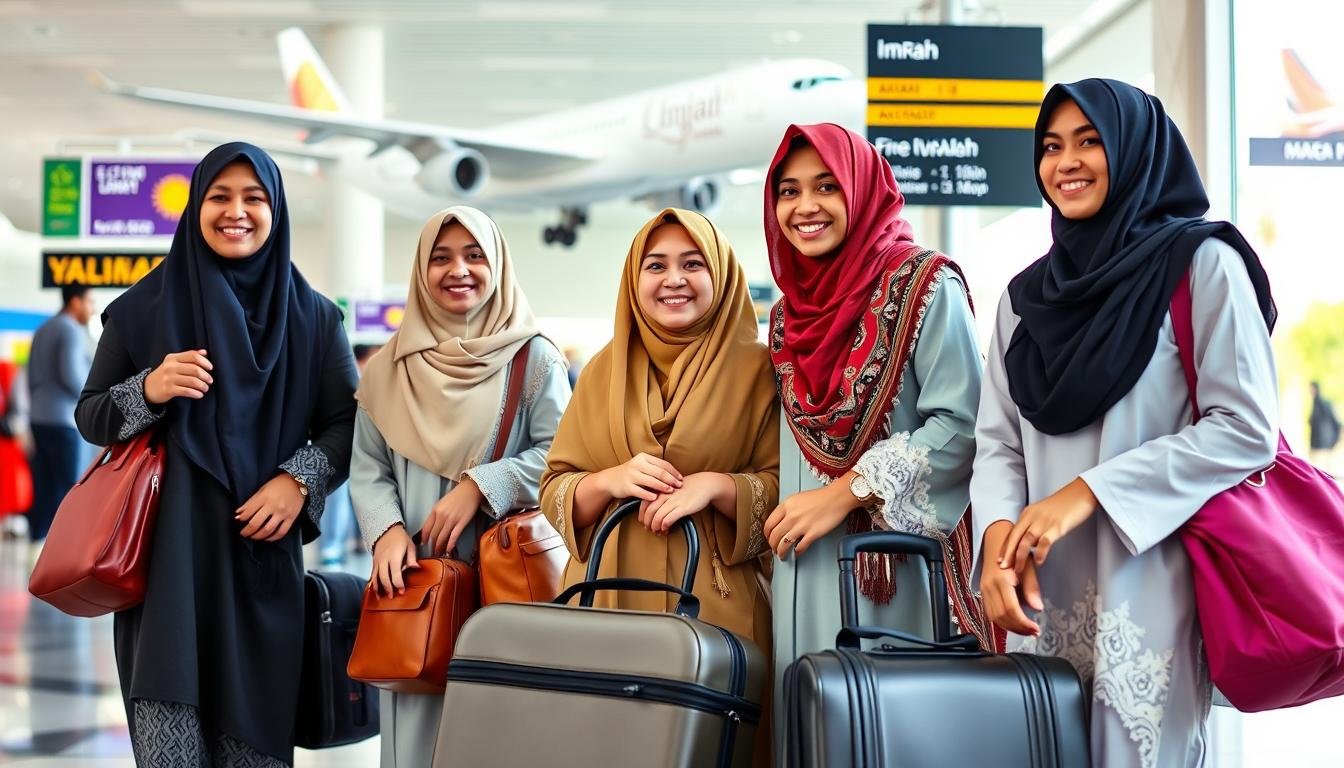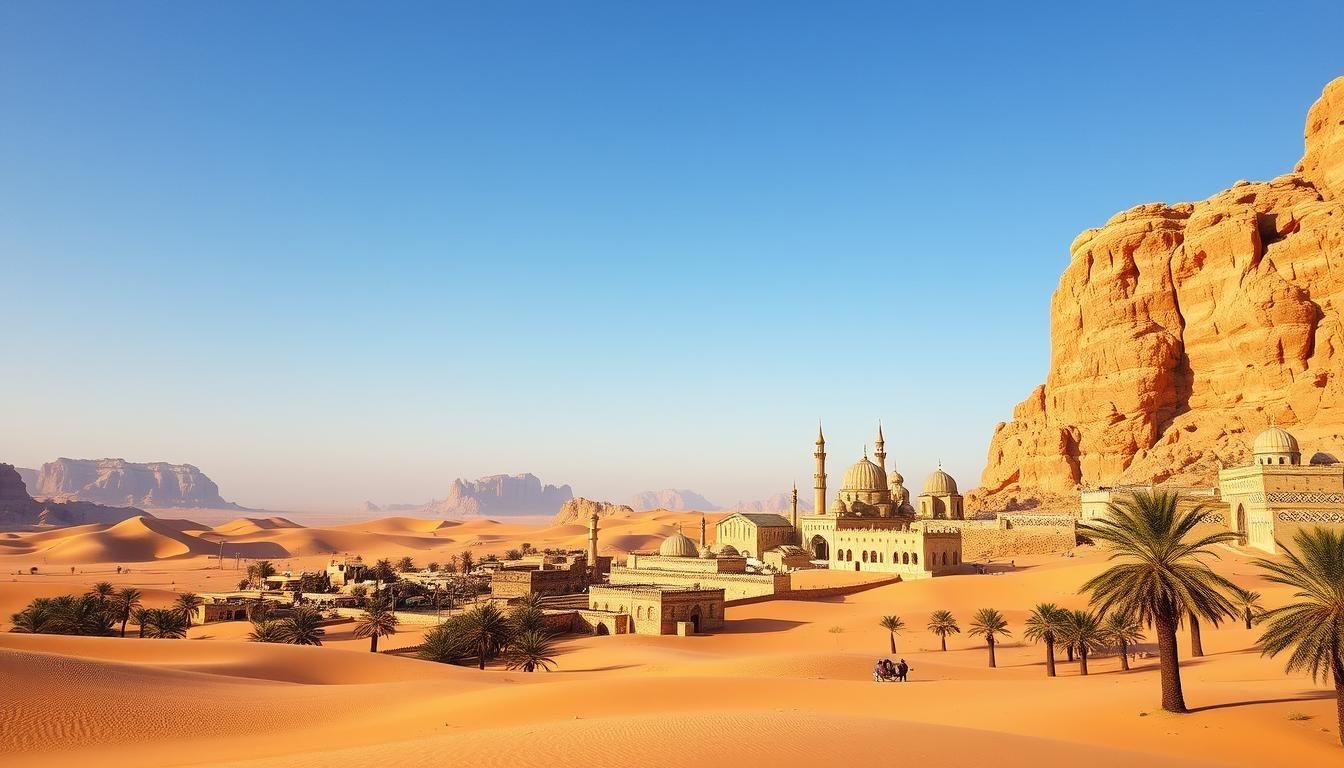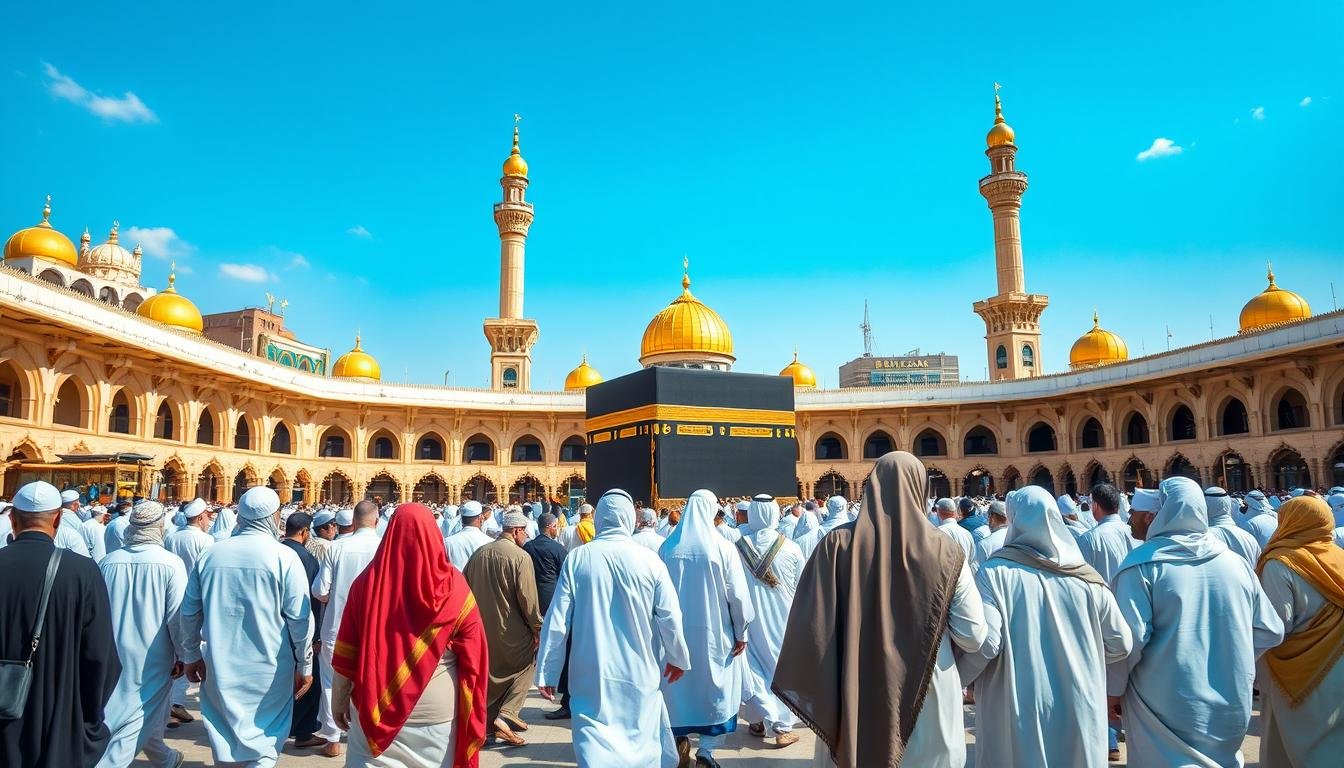Have you ever dreamed of a spiritual journey to the holiest places of our faith? Saudi Arabia, where Islam was born, is filled with sacred sites. But which ones should you visit first?
Let’s explore the most important Islamic sites in Saudi Arabia. We’ll look at the Kaaba in Mecca and the Masjid al-Nabawi in Medina. We’ll learn about their history, architecture, and spiritual value. This will help you plan a journey that changes your life.
Introduction to Saudi Arabia’s Religious Heritage
Saudi Arabia is a special place in the Islamic world. It is where Islam was born and has many sacred sites. The Prophet Muhammad received revelations here in the 7th century, starting the Muslim faith. This land has been a spiritual center for believers for centuries.
The country’s location makes it a key place for Islamic culture and learning. The holy cities of Mecca and Medina are in Saudi Arabia. They attract Muslims from everywhere who want to go on pilgrimage and connect with their faith’s roots.
| Key Islamic Historical Sites in Saudi Arabia | Spiritual Significance |
|---|---|
| The Kaaba in Mecca | The most sacred site in Islam, believed to be the first house of worship for one God |
| Masjid al-Haram in Mecca | The largest and one of the holiest mosques in the world, surrounds the Kaaba |
| Al-Masjid an-Nabawi in Medina | The second holiest site in Islam, built by the Prophet Muhammad |
| Mount Arafat near Mecca | The site where the Prophet Muhammad delivered his final sermon, a pivotal moment in Islamic history |
Places like these in Saudi Arabia draw Muslim pilgrims. They come to deepen their spiritual connection and honor the faith’s roots. The country’s care for these Islamic holy sites and its role in pilgrimages make it the heart of the Islamic world.
The Holy City of Mecca: Heart of Islam
Mecca is the holiest city in Islam, holding deep spiritual value for Muslims everywhere. At its center is the Kaaba, a sacred site for Islamic worship. This ancient building, with its rich history and cultural importance, draws millions of pilgrims each year during the Hajj.
The Sacred Kaaba and Its History
The Kaaba is a cube-shaped building covered in a black cloth with gold calligraphy. It’s believed to have been built by the Prophet Abraham and his son Ishmael. As the qibla, it’s the direction Muslims face during their daily prayers, making it the most sacred site in the Masjid al-Haram, the world’s largest mosque.
Masjid al-Haram Architecture and Expansion
The Masjid al-Haram surrounds the Kaaba, a vast complex that has grown over the years. It now holds the increasing number of pilgrims. The mosque’s calm and spacious atmosphere, along with its beautiful architecture, is truly inspiring for visitors.
Best Times to Visit Mecca
- The Hajj pilgrimage, happening annually in the 12th month of the Islamic calendar, is the peak time to visit Mecca. Millions of Muslims from all over the world come to perform this sacred ritual.
- Visiting during Ramadan, the Islamic holy month of fasting, is also popular. The city buzzes with spiritual activities and community gatherings during this time.
- The months of Shawwal and Dhul-Qa’dah are the best times to visit Mecca outside of the Hajj and Ramadan. The weather is mild, and the crowds are smaller.
Al-Masjid an-Nabawi: The Prophet’s Mosque in Medina
The Al-Masjid an-Nabawi, or the Prophet’s Mosque, is very important to Muslims everywhere. It’s in Medina, a city considered holy. It’s the second most sacred place in Islam, after the Masjid al-Haram in Mecca.
The mosque’s story is closely tied to Prophet Muhammad, peace be upon him. It was here that he started the first Islamic community. The mosque has grown and changed over the years, but its spiritual value remains strong.
The mosque’s design shows the beauty of Islamic culture. It has beautiful calligraphy, stunning domes, and tall minarets. Visitors can feel a calm and connect with the Prophet’s legacy.
Visiting the Al-Masjid an-Nabawi in Medina is a special experience. It’s for those who are deeply religious or just curious. It’s a place to think about Islam, feel close to the divine, and honor the Prophet Muhammad’s legacy.
Top Sacred Sites in Saudi Arabia Every Muslim Should Visit
Saudi Arabia is the birthplace of Islam and home to its holiest shrines. It offers a unique chance for Muslim pilgrims to embark on a spiritual journey. From the iconic Kaaba in Mecca to the serene Masjid al-Nabawi in Medina, these sites are crucial for every devout Muslim. Before starting this journey, it’s important to prepare well and know the visitor guidelines and etiquette.
Essential Preparations Before Visiting
To have a fulfilling and respectful experience, Muslim pilgrims should make these preparations:
- Get the necessary visas and permits, like the Hajj or Umrah visa, early.
- Learn about local customs and dress code, ensuring your clothes are modest and respectful.
- Check the schedules and timings for the sacred sites to plan your trip well.
- Refresh your knowledge of Islamic history and the importance of these holy places.
Visitor Guidelines and Etiquette
Visiting the sacred sites in Saudi Arabia requires following certain guidelines and etiquette:
- Dress modestly, covering your head and body as per Islamic dress code.
- Don’t take photos or videos inside the holy sites, unless allowed.
- Follow the rules and regulations set by the authorities, and listen to local guides or officials.
- Engage in silent contemplation and prayer, avoiding loud or disruptive behavior.
Best Seasons for Spiritual Journey
The best time to visit the sacred sites in Saudi Arabia depends on your preferences and activities. However, some of the best seasons include:
- Hajj season (the 12th month of the Islamic calendar) for an immersive experience during the annual pilgrimage.
- Ramadan (the 9th month of the Islamic calendar) for a deeply spiritual atmosphere and increased religious fervor.
- Spring and autumn seasons for more moderate weather and fewer crowds, allowing for a more contemplative experience.
By planning your visit carefully, respecting local customs, and embracing the sacred atmosphere, you can embark on a transformative spiritual journey through the most revered sites in Saudi Arabia.

Mount Arafat: The Mountain of Mercy
Every year, Muslims from all over the world come to Mount Arafat, also known as Jabal Rahmah. This mountain is called the “Mountain of Mercy.” It’s a place of great importance in Islam because it’s where the Prophet Muhammad gave his last sermon.
At Mount Arafat, pilgrims perform important rituals during the Hajj. They stand on the mountain’s slopes, praying and asking for forgiveness. This moment, called the “Wuquf” or “Standing,” is the highlight of the Hajj.
The history of Mount Arafat is closely tied to the Prophet Muhammad. It’s said that he gave his farewell sermon here. This event is remembered and reenacted by millions of pilgrims during the Hajj.
| Significance of Mount Arafat | Key Rituals Performed |
|---|---|
| Believed to be the site of Prophet Muhammad’s final sermon Considered the “Mountain of Mercy” in Islamic tradition Serves as the climax of the Hajj pilgrimage | Wuquf or “Standing” on the slopes of Mount Arafat Supplication and seeking forgiveness Reenactment of Prophet Muhammad’s farewell sermon |
Mount Arafat holds a special place in Islam’s history and teachings. When pilgrims climb the mountain, they fulfill a key part of the Hajj. They also connect with the Prophet Muhammad’s legacy and the heart of their faith.
The Sacred Valley of Mina: Significance and Rituals
Pilgrims on the Hajj journey visit the valley of Mina, a sacred site. It’s located east of Mecca and is key in Islamic tradition. Here, several important Hajj rituals take place.
Jamarat Bridge and Its Importance
The Jamarat Bridge is at Mina’s heart. It’s a multi-level structure for the Stoning of the Devil ritual. Pilgrims come here to stone three pillars, symbolizing their fight against evil.
The bridge has been updated to handle more pilgrims. This ensures a safe and smooth ritual experience.
Accommodation Options in Mina
Pilgrims in Mina have various places to stay. Many choose tents or shelters provided by the Saudi government. These offer basic needs and are close to sacred sites.
Others might prefer hotels or guesthouses, but these are pricier. Staying in Mina is a key part of the Hajj experience.
Mina’s valley, with its Jamarat Bridge, is dear to Muslims everywhere. During Hajj, pilgrims find comfort and connection in Mina’s sacred spaces. This strengthens their faith and commitment to its teachings.

Muzdalifah: The Sacred Ground Between Arafat and Mina
The Hajj pilgrimage is a journey of millions of Muslims each year. It’s deeply rooted in Islamic tradition. Muzdalifah, a sacred site, lies between Arafat and Mina.
Pilgrims spend the night in Muzdalifah, praying and thinking deeply. They collect pebbles for the Stoning of the Devil ritual in Mina. This act shows their rejection of temptation and commitment to righteousness.
Muzdalifah is special because of its history and spiritual value. The Prophet Muhammad (peace be upon him) spent a night here during the Farewell Pilgrimage. This set the example for today’s pilgrims.
Rituals and Significance of Muzdalifah
- Pilgrims come to Muzdalifah after Arafat, the Hajj’s peak.
- They spend the night praying and seeking forgiveness under the stars.
- They collect pebbles for the Stoning of the Devil ritual in Mina.
- This time is for reflection, preparing for the Hajj’s end.
Visiting Muzdalifah is a transformative experience for pilgrims. It deepens their faith and offers a chance for spiritual growth. Muzdalifah connects the devotion of Arafat to the Hajj’s end in Mina.
| Ritual | Significance |
|---|---|
| Spending the Night in Muzdalifah | Opportunity for contemplation, prayer, and spiritual preparation for the remaining Hajj rituals |
| Collecting Pebbles | Pebbles will be used in the Stoning of the Devil ritual, symbolizing the rejection of temptation |
| Connecting with the Divine | Pilgrims seek forgiveness, guidance, and a deeper spiritual connection during their time in Muzdalifah |
Historical Mosques and Sacred Sites in Medina
Medina, the second holiest city in Islam, is filled with historical mosques and sacred sites. These places are very important to Muslims all over the world. The Quba Mosque and Masjid al-Qiblatayn are especially revered. They were key in the early days of Islam.
Quba Mosque: The First Mosque in Islam
The Quba Mosque is known as the first mosque in Islamic history. It’s located on the outskirts of Medina. The Prophet Muhammad built it when he first arrived in the city.
This mosque shows the humble start of the Muslim community. Its simple yet powerful design inspires people from everywhere.
Masjid al-Qiblatayn’s Historical Significance
The Masjid al-Qiblatayn, or “Mosque of the Two Qiblas,” is another important mosque in Medina. It’s where the direction of prayer was changed from Jerusalem to the Kaaba in Mecca. This change happened during the Prophet Muhammad’s time.
This event shows how Islam has grown and changed. It’s a key part of Islamic history.
Visiting these mosques in Medina gives a deep look into Islam’s beginnings and growth. Exploring these places helps travelers understand the religion’s history. It also connects them with the spiritual traditions that shape Muslim lives today.
Modern Facilities and Services at Sacred Sites
Visiting Saudi Arabia’s sacred Islamic sites is now easier and more comfortable. The country has invested in modern facilities and visitor amenities. This includes accommodations, transportation, and healthcare, making the experience better for millions of visitors each year.
The range of accommodations is impressive. You can choose from luxury hotels to budget-friendly guesthouses. Many places offer 24-hour concierge services, prayer rooms, and halal food, meeting the needs of Muslim travelers.
The sites also have modern visitor amenities. Pilgrims can find shops, restaurants, and recreational facilities nearby. This makes their spiritual journey more comfortable and convenient.
The Saudi government has improved transportation to the sites. A network of buses, trains, and taxis connects Mecca, Medina, and other places. This makes it easy to get around and explore the spiritual landscape.
Healthcare is also a priority. State-of-the-art medical facilities and emergency services are near the sites. This lets visitors focus on their spiritual journey without worrying about their health.
Saudi Arabia has made it possible for visitors to fully experience the spiritual and cultural richness of its sacred sites. At the same time, it ensures their comfort and convenience during their pilgrimage.
Transportation and Accessibility Between Holy Sites
Traveling between the holy sites in Saudi Arabia is easy. The country has a strong public transit system and guided tours. This makes exploring these sacred places more accessible than ever.
Public Transit Options
The holy sites are connected by a good public transport network. Buses and trains run often, offering a cheap and reliable way to travel. They make it easy to enjoy the spiritual feel of the area.
Guided Tour Services
Guided tours are perfect for a more personal and educational trip. Local guides lead these tours, sharing their knowledge of the sites’ history and culture. Joining a tour can deepen your understanding of Islam and its traditions.
FAQ
What are the most important sacred sites in Saudi Arabia that every Muslim should visit?
Muslims should visit Mecca, the holy city, and the Kaaba. Medina is also key, with the Al-Masjid an-Nabawi. Mount Arafat, Mina, and Muzdalifah are important for the Hajj pilgrimage.
What is the historical and spiritual significance of Mecca?
Mecca is the holiest city in Islam. It’s where the Prophet Muhammad was born. The Kaaba, a sacred cube, is here. It’s the direction of prayer for Muslims.
The Masjid al-Haram, the largest mosque, surrounds the Kaaba. It’s a central site for Islamic pilgrimage and worship.
Can you explain the importance of the Al-Masjid an-Nabawi in Medina?
The Al-Masjid an-Nabawi, or the Prophet’s Mosque, is very important. It was built by the Prophet Muhammad. It’s where he is buried, making it a sacred place for Muslims.
What is the significance of Mount Arafat and the Hajj pilgrimage?
Mount Arafat, or Jabal Rahmah, is where the Prophet Muhammad gave his final sermon. It’s the peak of the Hajj. Pilgrims gather here to pray and seek forgiveness.
Can you provide an overview of the sacred valley of Mina and its importance?
Mina is a key site for Hajj rituals. It’s where pilgrims throw stones at the Jamarat Bridge. Mina is also a campsite for millions during the Hajj.
What is the role of Muzdalifah in the Hajj pilgrimage?
Muzdalifah is between Arafat and Mina. Pilgrims collect pebbles here for the Stoning of the Devil ritual. It’s a place for prayer and reflection.
Can you highlight some of the other historical mosques and sacred sites in Medina?
Medina has more than the Al-Masjid an-Nabawi. There’s the Quba Mosque, the first mosque, and the Masjid al-Qiblatayn. It’s known for the change in the Qibla direction.
What modern facilities and services are available at the sacred sites in Saudi Arabia?
The sacred sites in Saudi Arabia have modern facilities. They offer accommodations, transportation, healthcare, and more. These services aim to improve the pilgrimage experience.
How can visitors travel between the different holy sites in Saudi Arabia?
Visitors can travel between sites using public transit, tours, or private transport. The government has improved access and connectivity. This makes the journey easier for pilgrims.
Don’t forget to share your experience in the comments and follow us on social media at the bottom of the site.






